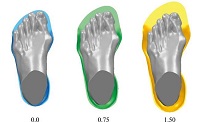Machining Parameter Optimization of EVA Foam Orthotic Shoe Insoles
DOI:
https://doi.org/10.46604/ijeti.2020.5099Keywords:
shoe insole, EVA foam, CNC milling, surface roughness (Ra), machining timeAbstract
In this study, ethylene-vinyl acetate (EVA) foam orthotic shoe insoles with different surface roughnesses (Ra) are investigated in terms of CNC milling strategy. Based on a hybrid Taguchi-response surface methodology (TM-RSM) approach, machining parameters, including tool path strategy, spindle speed, feed rate, and step over, as well as material hardness, are of particular interest. The main aim of this work is to develop mathematical models and determine the optimum machining parameters. Experiments are conducted on a CNC milling machine with a standard milling cutter and run under dry coolants. The optimal conditions are established based on TM and then used to determine the optimum values in the RSM modeling. The main finding of the present work is that there are significant improvements in the Ra, by up 0.24% and 4.13%, and machining time, by up 0.43% and 0.41%, obtained with TM-RSM in comparison to TM analysis.
References
Y. P. Wu, Y. Ma, Y. Q. Wang, and L. Q. Zhang, “Effects of characteristics of rubber, mixing and vulcanization on the structure and properties of rubber/clay nanocomposites by melt blending,” Macromolecular Materials and Engineering, vol. 289, no. 10, pp. 890-894, October 2004.
E. T. Nurit, W. Ety, H. F. Yifat, and G. Amit, “Role of EVA viscoelastic properties in the protective performance of a sport shoe: computational studies,” Journal Bio-Medical & Material Engineering, vol. 16, no. 5, pp. 289-299, 2006.
Y. R. Jeng, S. Liu, and H-T. Yau, “Designing experimental methods to predict the expansion ratio of EVA foam material and using finite element simulation to estimate the shoe expansion shape,” Material Transactions, vol. 53, no. 9, pp. 1685-1688, September 2012.
P. W. Anggoro, B. Bawono, A. Widiyanto, Jamari, and A. P. Bayuseno, “Parameter optimization of strategies at the CNC milling machines rolland model MDX 40R cam surface roughness against shoe orthotic insole made of EVA foam rubber,” International Journal of Mechatronics and Mechanical Engineering, vol. 6, no. 4, pp. 96-104, 2016.
P. W. Anggoro, E. Saputra, M. Tauviqirrahman, Jamari, and A. P. Bayuseno, “A 3-dimensional finite element analysis of the shoe insole orthotics for foot deformities,” International Journal of Applied Engineering Research, vol. 12, no. 15, pp. 5254-5260, 2017.
P. W. Anggoro, M. Tauviqirrahman, Jamari, A. P. Bayuseno, B. Bawono, and M. M. Avellina, “Computer-aided reverse engineering system in the design and production of orthotic insole shoes for patients with diabetes,” Cogent Engineering, vol. 5, no. 1, pp. 1-20, June 2018.
P. W.Anggoro, M. Tauviqirrahman, Jamari, A. P. Bayuseno, J. Wibowo, and Y. D. Saputro, “The optimal design and manufacturing of shoe last product for an ankle foot orthotic for the patient with diabetes,” International Journal of Manufacturing, Materials, and Mechanical Engineering, vol. 9, no. 2, pp. 62-80, April 2019.
M. Pracella, Minhaz-Ul Haque, and V. Md. Alvarez, “Functionalization, compatibilization, and properties of polyolefin composites with natural fibers,” Polymers Journal, vol. 2, no. 4, pp. 554-574, November 2010.
Y. Shimazaki, S. Nozu, and T. Inoue, “Shock-absorption properties of functionally graded EVA laminates for footwear design,” Polymer Testing, vol. 54, pp. 98-103, July 2016.
X. Ye, H. Liu, L. Chen, Z. Chen, X. Pan, and S. Zhang, “Reverse innovative design - an integrated product design methodology,” Computer Aided Design, vol. 40, no. 7, pp. 812-827, August 2008.
M. Sarikaya and A. Gullu, “Taguchi design and response surface methodology-based analyses of machining parameters in CNC turning under MQL,” Journal of Clean Production, vol. 65, pp. 604-616, 2014.
I. Asiltürk and S. Neseli, “Multi-response optimization of CNC turning parameters via Taguchi method-based response surface analysis,” Measurement, vol. 45, no. 4, pp. 785-794, January 2012.
R. N. Yadav, “A hybrid approach of taguchi-response surface methodology for modeling and optimization of duplex turning process,” Measurement, vol. 100, pp. 131-138, January 2017.
A. N. Sait, S. Aravindan, and A. N. Haq, “Optimization of machining parameters of glassefibre-reinforce plastics analysis technique using Taguchi,” International Journal of Advanced Manufacturing Techniques, vol. 43, pp. 581-589, 2009.
B. Bawono, P.W. Anggoro, M. Tauviqirrahman, A. P. Bayuseno, and Jamari, “The Evaluation of the Use of AFO (ankle foot orthotics) with the MOXFQ (manchester-oxford foot questionnaire) method,” Atlantis Highlights in Engineering, vol. 1, pp. 657-662, 2018
P. W. Anggoro, B. Bawono, M. Tauviqirrahman, A. P. Bayuseno, and Jamari, “Design and manufacturing orthotics shoe insole with optimum surface roughness using the CNC milling,” Journal of Engineering Science and Technology, Vol. 14, No. 4, pp. 1799-1819, 2019.

Published
How to Cite
Issue
Section
License
Copyright Notice
Submission of a manuscript implies: that the work described has not been published before that it is not under consideration for publication elsewhere; that if and when the manuscript is accepted for publication. Authors can retain copyright in their articles with no restrictions. Also, author can post the final, peer-reviewed manuscript version (postprint) to any repository or website.

Since Jan. 01, 2019, IJETI will publish new articles with Creative Commons Attribution Non-Commercial License, under Creative Commons Attribution Non-Commercial 4.0 International (CC BY-NC 4.0) License.
The Creative Commons Attribution Non-Commercial (CC-BY-NC) License permits use, distribution and reproduction in any medium, provided the original work is properly cited and is not used for commercial purposes.







.jpg)


